by Valentina Biondini, art and literature amateur
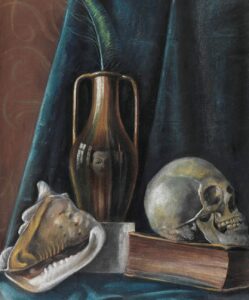
Alberto Martini was an Italian artist with many talents who strongly influenced the imagination of his own and the following era. Today his fame is almost exclusively relegated to the lovers of fantastic art, but actually Martini was also a symbolist painter, a precursor of Surrealism, as well as an illustrator of literary texts with a precise and refined line. It is no coincidence that in London, on the occasion of his exhibition in 1914, he was nicknamed “Italian pen-and-ink genius”. As an illustrator, he created images combined with texts by Dante Alighieri and Luigi Pulci, but also by Edgar Allan Poe and William Shakespeare, the poems of Paul Verlaine and the work “Poemetti in prosa” by Mallarmé.

Born in 1876 in Oderzo, in the province of Treviso, to the painter and illustrator Giorgio Martini and the countess Maria Spineda de Cattaneis, from an early age he showed a marked predilection for drawing and graphics. And, after all, from 1897 he took part in 14 consecutive editions of the Biennale. Fundamental for him was his meeting with the neapolitan critic, and first director of the Biennale, Vittorio Pica who, in 1912, encouraged him to dedicate himself to a pictorial production, making use above all of the pastel technique. Often invited to exhibit abroad, from Munich to Berlin, from Brussels to London and Paris (where he lived from 1928 to 1934 in the Montparnasse district), he spent the last twenty years of his life in Milan, where he died in 1954.

His highly visionary works and often astonishing technique were able to deeply nourish the avant-gardes, from Futurism to Surrealism, and to fertilize the imagination of artists and musicians, as well as to influence the world of theater and cinema with his original and powerful suggestions, still perceptible. Even Alfred Hitchcock in the film “The Birds” inserts explicit references to his illustrations for Edgar Allan Poe’s “Tales”. To fully immerse yourself in the atmosphere that nourished the imagination of this great visionary artist, today in his hometown it’s possible to visit his house-museum. And if, fantasizing, we thought we could conduct an interview with Martini for Who’s next, we imagine that he would begin like this, telling us that…
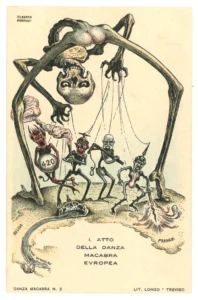
I approached art when I was still a child thanks to my father’s teachings, also a painter and designer. Constant practice, if not daily, allowed me to develop a technique that years later critics defined as infallible. In fact, as I always say: “My pen is, depending on the case, strong as a burin and light as a feather“. My imagination was already overflowing with skeletons, monsters, apes, crows and skulls when, at the outbreak of the First World War, this imagery flowed, I would say almost naturally, into 54 lithographs that later took the name of Danse Macabre. I’m not sure if you know but those drawings, printed in postcard format, were distributed among the English allies as war propaganda to incite them to fight against the vile German enemy. I can only be pleased about this.
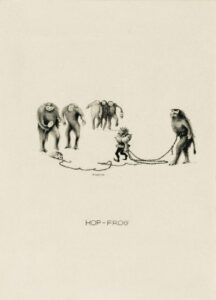
Others, however, may have felt my name linked to the illustrations of noble poets and writers. In this respect, without a doubt, my most ambitious project is represented by the cycle of illustrations for the Extraordinary Tales of Edgar Allan Poe, composed of 105 drawings that I made between 1905 and 1908, but which I continued to work on until 1936. I was fascinated by this American author’s obsessive analysis of detail, his exploration of the double and the unconscious and the magnetic and surreal atmosphere that permeated his stories. All themes that I instinctively felt were also mine. I had a sort of ideal dialogue with him and I did not limit myself to illustrating his texts, but I created, so to speak, a real visual poem no less dizzying than the original, interpreting and amplifying the writer’s already fertile imagery. As in a hall of mirrors, I was able to visually translate even the minor and apparently irrelevant details of his literary tale, as in the case of The Descent into the Maelstrom, The Crow, Hop Frog, Black Cat.
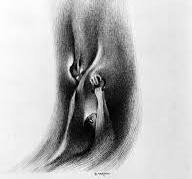
I don’t think I’m guilty of pride if I say that the hallucinatory visions and macabre details of the dream universe created by my imagination could fascinate the future generations. Who knows if it will really be the case, posterity will be the ar…tistic judge. However, starting from the end of the 1920s, fortune turned its back on me, critics began to ignore my works and so I decided to move across the Alps, to Paris. And as they say, every cloud has a silver lining because, ça va sans dire, the french capital represented an extraordinary opportunity to develop my symbolist streak. It was then that I illustrated the works of Rimbaud, Baudelaire and De Vigny.
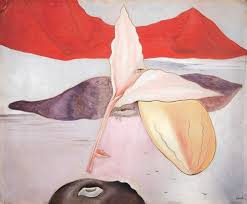
My finances, however, which needed much more nourishment than my creative flair, suffered from the parisian life and already in the mid-1930s I had to return to Italy, here in Milan, the city from which I am speaking to you right now. Here, in my house, it usually happens that “The large window of my studio is open in the night. In that black rectangle my ghosts pass and I love to converse with them. They incite me to be strong, indomitable, heroic, they whisper secrets and mysteries that perhaps I will tell you. Many will not believe and I feel sorry for them, because those who have no imagination vegetate in slippers: a comfortable life, but not the life of an artist”. Now then it is time to say goodbye, my ghosts are calling me. It is with them that I must continue to converse tonight, as my art demands.